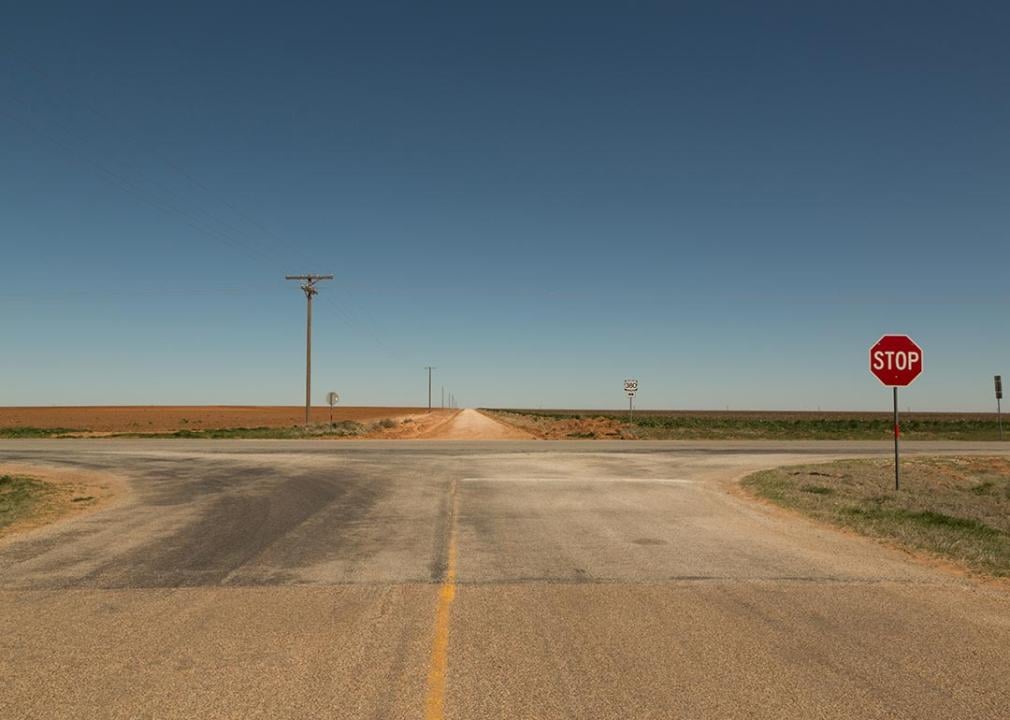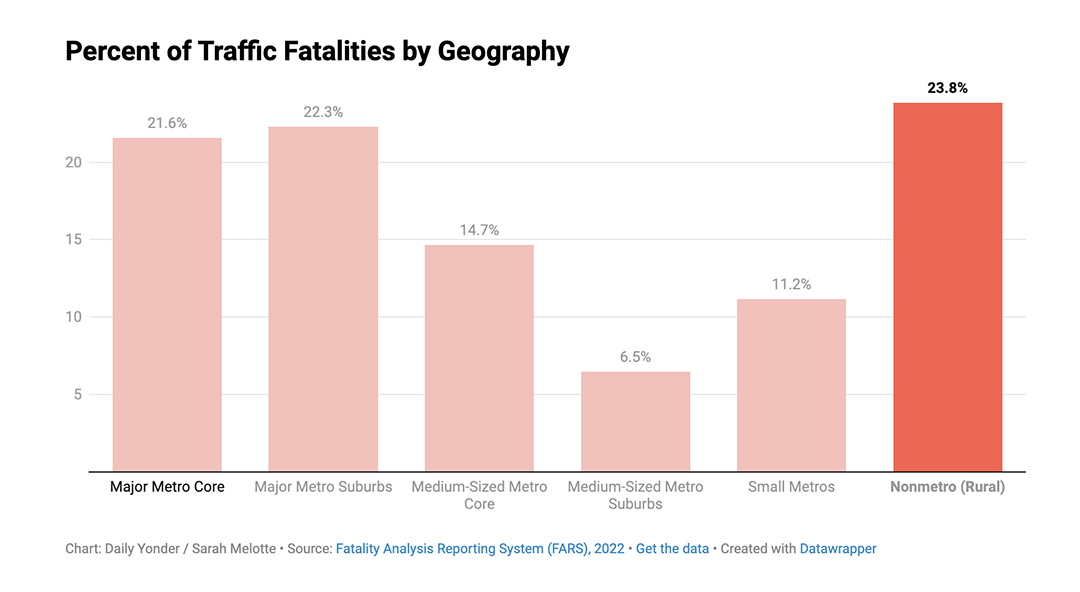Data shows rural disparities in traffic deaths

Stephen Allen Photography // Shutterstock
Data shows rural disparities in traffic deaths
A rural intersection in Texas with a stop sign and a blue sky in the background.
Rural counties experience more traffic deaths per capita compared to their urban counterparts, due in part to slower emergency response times, higher speed limits, and risky driving behavior like not wearing seatbelts.
Six lane interstates and city streets in densely developed urban areas aren’t more dangerous than open stretches of highway, no matter how nasty rush hour traffic may get. An analysis by The Daily Yonder shows that traffic deaths are higher in rural counties, when deaths are measured as a share of the total population of the county where the accident took place.
According to data from the Fatal Accident Reporting System (FARS) compiled by the Federal Highway Administration (FHA), nonmetropolitan, or rural, counties saw approximately 10,000 traffic fatalities in 2022, a slight decrease from 10,400 in 2021. The FHA reports traffic deaths to improve road safety, allocate resources, and enhance the public’s awareness of road safety.
The FARS dataset records where accidents happened, not where the victim lived. Since not everyone driving through a county is a resident of that county, it can be difficult to track down whether rural residents are more likely to die in car accidents compared to urban residents using the FARS dataset. This means the death rate per capita measure used in this analysis reflects how many fatalities occur in rural counties compared to their population size, not the number of rural residents who died.
Although the per capita measure isn’t perfect, it more accurately accounts for the higher incidence of traffic fatalities in rural areas, as it provides a standardized way to compare fatalities across different population sizes. This approach is supported by studies that indicate rural roads are more dangerous than urban ones.
For example, the Governors Highway Safety Association (GHSA) found that the risk of dying in a car accident is 62% higher on a rural road compared to an urban road of the same trip length.
Traffic Deaths Vary by Geography
In 2022, the most recent year of available data, rural deaths represented about a quarter of all traffic fatalities.
- Major metropolitan areas with over 1 million residents reported 9,050 fatalities in 2022, accounting for 21% of the nation’s traffic deaths. Residents of major metros comprise 28% of the total population. The death rate per 100,000 residents was 9.9 in the nation’s largest cities.
- Suburban areas of major metropolitan counties experienced 9,400 fatalities in 2022, making up 22% of the total number of deaths despite accounting for about 29% of the total population. The death rate was 9.9 deaths per 100,000 residents in these counties.
- Medium-sized metropolitan areas, with populations between 250,000 and 1 million people, had 6,100 deaths, representing 14% of all deaths in 2022. Residents of medium-sized cities comprise 15% of the total population. The traffic death rate in these counties was 12 deaths per 100,000 people.
- The suburbs of medium-sized metropolitan counties reported 2,700 deaths in 2022, which accounted for 7% of all deaths. 5% of Americans live in the suburbs of medium-sized metros. The traffic death rate in these counties was 15.4 deaths per 100,000 residents.
- Small metros with fewer than 250,000 residents, meanwhile, recorded 4,700 fatalities, accounting for 11% of all traffic deaths. Residents of small metros account for about 9% of the total population. The death rate in small metros was 15.6 deaths per 100,000 residents in 2022.
![]()

Daily Yonder // Sarah Melotte
Pandemic-era Surge in Traffic Fatalities Eases Slightly
Bar graph showing percent of traffic fatalities by geography.
Traffic fatalities increased nationwide during the pandemic, from 36,000 deaths in 2019, up to nearly 43,000 in 2021, a 19% increase in deaths. Rural counties added 1,000 more traffic deaths during this time, accounting for an 11% increase in deaths.
A 2022 study from the AAA Foundation for Traffic Safety showed that more risky driving behavior, such as not wearing seatbelts, was the primary cause of the increase in traffic deaths during the pandemic.
But traffic deaths decreased by about 800 deaths nationwide between 2021 and 2022. In 2022, there were about 400 fewer traffic deaths in rural counties compared to 2022.

Daily Yonder // Sarah Melotte
What Causes Traffic Deaths in Rural Counties?
Bar graph showing Death Rates of Traffic Fatalities, 2022.
Rural counties take up a greater share of land area, resulting in more miles of roads and, consequently, more opportunities for accidents. But experts say road mileage isn’t the only cause of high traffic deaths in rural America. Longer emergency responses and risky driving behaviors are often the culprits of disproportionately high rural traffic deaths.
A 2023 report from the Rural Health Research and Policy Center found that ambulance response times in rural counties were double those of urban counties, which contributes to higher traffic mortality in those areas. Shorter emergency response times are generally associated with better patient outcomes and decreased mortality, meanwhile.
In a 2022 report, the GHSA stated that fatal crashes involving speeds higher than 100 miles per hour tend to happen on rural roads, and that states with higher maximum speed limits also have higher traffic fatalities on rural roads. It also found that speeding was a particular problem in rural areas and was responsible for 27% of traffic deaths between 2016 and 2020.
According to the Behavior Risk Factor Surveillance System, a phone survey collected by the CDC, rural Americans were more likely to self-report that they don’t wear seatbelts. In the nation’s most rural counties—areas with fewer than 5,000 people and not adjacent to a city—only 75% of respondents in the BRFSS survey reported wearing seatbelts. In contrast, that number was 89% in the nation’s most urban counties. The CDC attributes this risky behavior to higher traffic mortality in rural counties.
This story was produced by The Daily Yonder and reviewed and distributed by Stacker Media.